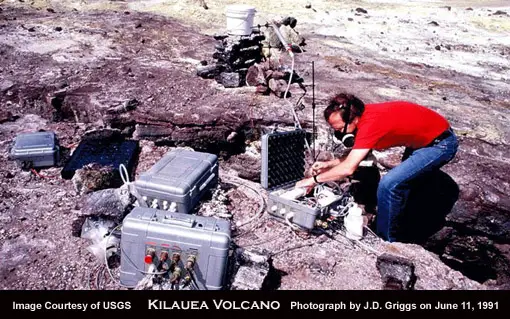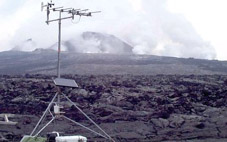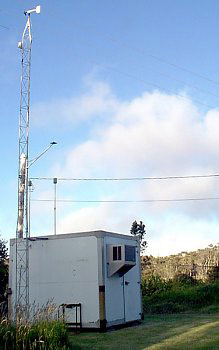Continuous volcano monitoring has the advantage of being able to detect both short-lived degassing events that occur in time periods lasting minutes to hours as well as long-term changes that occur over days to years. A monitoring station can be set up to monitor fumarole gases, the air around the volcano, or soil gases depending on what the specific requirements are. Data can be taken from the sensor(s) every few minutes and transmitted by radio, satellite, or telephone line to a central observation location.

The USGS conducts continuous gas monitoring at the Hawaiian Volcano Observatory (HVO) to assess current eruptive activity and hazards of Kilauea and Mauna Loa volcanoes and to improve understanding of how these and other volcanoes work. Hawaiian volcanoes, because of their accessibility and effusive nature, serve as an ideal test sites for developing new techniques for volcanic gas studies. Among these techniques is continuous volcano monitoring.  The picture to the left shows monitoring near the Pu`u `O`o vent (cone in background) located on Kilauea’s east rift zone. A small computer controls instrumentation which periodically samples the air near Chemically-selective sensors for SO2 and CO2 measure gas concentrations and a wind sensor measures wind speed and direction. Data from this solar-powered station are transmitted to HVO every 10 minutes, providing near real time data on degassing from Pu`u `O`o.
The picture to the left shows monitoring near the Pu`u `O`o vent (cone in background) located on Kilauea’s east rift zone. A small computer controls instrumentation which periodically samples the air near Chemically-selective sensors for SO2 and CO2 measure gas concentrations and a wind sensor measures wind speed and direction. Data from this solar-powered station are transmitted to HVO every 10 minutes, providing near real time data on degassing from Pu`u `O`o.  On the right is an image of an ambient air quality monitoring station located at the summit of Kilauea. This station is run by the National Park Service and the USGS. The station measures concentrations of SO2 gas down to parts per billion (ppb) and provides information about the impact of volcanic emissions on air quality. Data from this site help confirm the importance of wind speed and direction on the geographic distribution and concentration of volcanic air pollution. The station is also part of a nationwide network of air monitoring sites that operate within National Parks.
On the right is an image of an ambient air quality monitoring station located at the summit of Kilauea. This station is run by the National Park Service and the USGS. The station measures concentrations of SO2 gas down to parts per billion (ppb) and provides information about the impact of volcanic emissions on air quality. Data from this site help confirm the importance of wind speed and direction on the geographic distribution and concentration of volcanic air pollution. The station is also part of a nationwide network of air monitoring sites that operate within National Parks.
When the wind the wind blows form a particular quarter, emissions from the Kilauea volcano impact on the populated summit area. USGS indicate that data from this site show that health standards for SO2 (145 ppb) have been exceeded more than 80 times during the past 13 years. An alert system using the data from this station informs staff of the Hawai`i Volcanoes National Park of the presence of potentially unhealthy concentrations of SO2 gas during episodes of very poor air quality.
